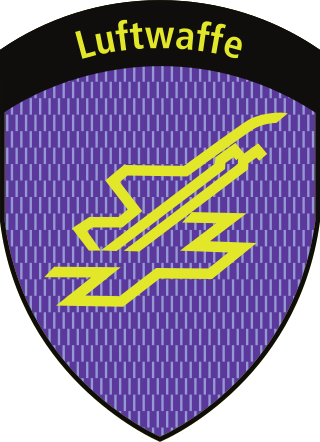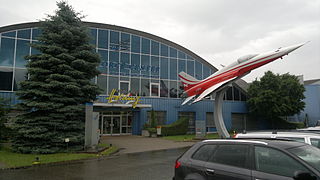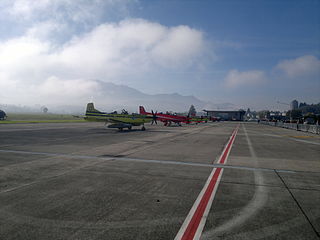
The Dassault Mirage III is a family of single/dual-seat, single-engine, fighter aircraft developed and manufactured by French aircraft company Dassault Aviation. It was the first Western European combat aircraft to exceed Mach 2 in horizontal flight, a feat which was achieved on 24 October 1958.

The Swiss Air Force is the air component of the Swiss Armed Forces, established on 31 July 1914, three days after the outbreak of World War I, as a part of the army and in October 1936 as an independent service.

The Patrouille Suisse is an aerobatic team of the Swiss Air Force. The team flies six Northrop F-5E Tiger II fighter jets.

The PC-7 Team is an aerobatics team of the Swiss Air Force. It derives its name from the Pilatus PC-7 trainer, the team's primary aircraft.
The history of the Swiss Air Force began in 1914 with the establishment of an ad hoc force consisting of a handful of men in outdated and largely civilian aircraft. It was only in the 1930s that an effective air force was established at great cost, capable of inflicting several embarrassing defeats on the Nazi Luftwaffe in the course of an initially vigorous defence of neutral Swiss airspace. The Swiss Air Force as an autonomous military service was created in October 1936. After World War II it was renamed the Swiss Air Force and Anti-Aircraft Command and in 1996 became a separate service independent from the Army, under its present name Schweizer Luftwaffe.

Sion Airport is the airport of the city of Sion, Switzerland and is located 2.5 km southwest of Sion city in the Rhone Valley. The airport opened in 1935.
Aircraft cavern, a calque of the German word Flugzeugkaverne, is an underground hangar amongst others used by the Swiss Air Force.

An underground hangar is a type of hangar for military aircraft, usually dug into the side of a mountain for protection. It is bigger and more protected than a hardened aircraft shelter (HAS).

International Locarno Airport, mil ICAO code LSMO, also known as Locarno-Magadino Airport, is an airport located near the city of Locarno, Ticino, Switzerland. It is a mixed civilian and military airport. The airfield is used simultaneously by civilian aircraft and the Swiss Air Force from the "airfield command Locarno". Although they use the same runways, the Swiss Air Force has its own taxiways and parking and a large hangar. It is located in the community of Gordola, seven kilometers east of the Locarno city center. The nearest stop to the Swiss Federal Railways is the 2 km distant station Riazzino of railway Giubiasco Locarno.

Payerne Airport is a military airfield of the Swiss Air Force north of Payerne in Switzerland, located approximately halfway between Lausanne and Bern.

Meiringen Air Base, also known as the Unterbach Military Airfield, is a Swiss military airbase located near the hamlet of Unterbach and the town of Meiringen, in the canton of Bern. It is one of three main airbases of the Swiss Air Force.

The Flieger Flab Museum is located in the Canton of Zurich in Dübendorf on the grounds of Dübendorf Air Base. In the museum, 40 airplanes and helicopters are displayed, with the collection divided into distinct eras: pioneers and World War I, the 1930s, World War II and the postwar period, the beginning of the jet age, the development of jet fighters, the Cold War, and arms reduction.

Dübendorf Military Airport was a military airfield of the Swiss Air Force northeast of Dübendorf in Switzerland, located east of Zürich.

Militärflugplatz Emmen is a military airfield of the Swiss Air Force north of Emmen, Switzerland, located northwest of Lucerne.

Riviera Airport is a former military airfield of the Swiss Air Force at Lodrino, Ticino in Switzerland. From July 2023 the ICAO location indicator LSPR replaces both LSML and LSXR. Not to be confused with the similarly named airport in Italy Riviera Airport

The Air Base Alpnach is a Swiss Air Force airfield near the town Alpnach in Canton of Obwalden in Switzerland. It has a concrete runway with a length of 1,500 meters (4,900 ft) and a width of 40 meters (130 ft), as well as several taxiways and hangars.
In Switzerland, to identify individual aircraft, all military aircraft are allocated and display a serial number.

Fliegerstaffel 10 was a Swiss Air Force unit consisting of professional military pilots, belonging to the Überwachungsgeschwader. Their home base at the dissolution was the Military Airfield at Buochs, where ist was equipped with Mirage IIIRS. Fliegerstaffel 10 carried as their coat of arms the AMIR badge. This badge shows on a white ground a falcon head drawn with black lines, the neck of which is filled with blue color. The beak rises above the round badge, above the head of the falcon is a number 10 in red. Except for the number 10, the badge is identical to the AMIR badge of the Fliegerstaffel 3 and the Fliegerstaffel 4.

The Fliegerstaffel 16 of the Swiss Air Force was last equipped with Northrop F-5 F aircraft. Their home base was Sion Airport. The Fliegerstaffel 16 had a shield-shaped coat of arms showing the side view of a black dragon with a red eye, red claws, and a red firebeam in front of the white digit 16 and a dark blue background. The old badge was the same, but in round design.

Fliegerstaffel 19 of the Swiss Air Force is a militia squadron equipped with Northrop F-5E and forms together with Fliegerstaffel 18 Fliegergeschwader 14. The home base of the fliegerstaffel 19 is Sion Airport. The "Fliegerstaffel 19" carries as a coat of arms a stylized swan on a blue background.



















